With the rise of emerging technologies, the growth of furniture ecommerce has been particularly significant. Selling furniture online presents unique challenges, especially when compared to smaller items like books or electronics. The ecommerce furniture sector, valued at approximately $27.7 billion in 2023, is projected to exceed $40 billion by 2030.
For those considering integrating an ecommerce aspect to their physical store or those skilled in selling custom or used furniture, there’s still plenty of opportunity to enter the market. This article delves into types of sellers, the process of setting up an online business, as well as strategies on how to sell furniture online tailored for different types of sellers.
Let’s understand your goal first
To craft a successful online strategy, it’s essential to pinpoint your unique selling position and objectives. Let’s delve into the different profiles of furniture sellers, and if you identify with any of these, we’ll guide you toward the best way to sell furniture online.
Seller type 1: You make furniture and now want to go online
If you’re a craftsman, artisan, or business owner passionate about creating custom furniture, you understand the dedication and skill that goes into each piece. Now you want to go online and showcase your work to a wider audience. However, as you explore how to sell furniture online, you’ll realize that transitioning online isn’t just about sales; it’s about establishing a digital brand presence and making the right decisions.
Recommendation: Setting up your online store is the way to capture your brand’s essence and provide a personalized shopping experience. For a step-by-step guide on building a digital presence that mirrors your craftsmanship, we recommend option 1: creating your own online store for selling furniture, where we’ll discuss:
- Reasons to establish your own online store.
- Step-by-step guide to seamlessly set up your digital storefront.
- Proven strategies and tips to promote and grow your online furniture business.
Seller type 2: You want to resell furniture online (dropshipping)
If you’re drawn to the furniture market but aren’t involved in the manufacturing process, dropshipping might be your best option. By understanding market trends and curating selections, you can present high-demand products without the overheads of traditional retail.
Recommendation: A combination of your own online store and trusted marketplaces can be the key to establishing a strong brand identity and expanding your reach. To begin on the journey of curating and selling without inventory hassles, consider option 1: creating your own online store for selling furniture as outlined for seller one.
As a seller, you can also leverage the vast customer base of renowned ecommerce platforms. To go deeper into the process of reselling, consider checking option 2: selling furniture on big marketplaces like Amazon and eBay where we will discuss:
- Benefits and drawbacks of selling furniture in an online marketplace.
- Best place to sell furniture online.
- Tips to successfully sell furniture in an online marketplace.
Seller type 3: You want to sell your used furniture
If you have furniture pieces that no longer fit your current space or personal taste, you can tap into this market and sell them online. While ‘online’ is a wide term, selecting the right online platform to sell your furniture can be challenging.
Recommendation: Social media platforms are ideal for showcasing and selling pre-owned items. If you want to sell your furniture on social media platforms, check out option 3: selling furniture exclusively on social media to get more insights where we’ll discuss:
- Perks of using social media for sales.
- Potential challenges of selling solely on social platforms.
- Tips to effectively showcase and sell your furniture on various social channels.
Option 1: Creating your own online store for selling furniture (best for seller types 1 and 2)
Whether you want to sell your custom-made furniture online or are interested in furniture dropshipping, the best way to sell furniture online is to create a user-friendly online store that guides buyers seamlessly through their purchasing journey.
Let’s explore reasons to set up your own store and how to sell furniture online by designing your own website:
Reasons to set up your own online store
Establishing a digital storefront for furniture sales offers a number of significant benefits. For instance, expanding online overcomes the physical boundaries of traditional stores. Being online enables you to serve a global audience, significantly boosting potential sales and revenue opportunities.
Here are some of the other reasons to consider launching your own online furniture platform:
1. Search engine optimization
Owning an online store facilitates optimization for search engines, ensuring your products rank prominently in Google searches. This is a major advantage over competing on vast platforms like Amazon or eBay. Utilizing the right SEO tools can greatly enhance the organic reach of your platform. For a deeper understanding of SEO tools and strategies, check out this comparison between All in One SEO and Yoast.
2. Streamlined B2B operations
While platforms like eBay and Amazon cater predominantly to B2C markets, having your own website simplifies B2B transactions. External platforms often come with restrictive approval processes. Moreover, potential investors are more inclined towards businesses that operate autonomously without external platform constraints.
3. Setting your own guidelines
With your own ecommerce store, you can directly shape the consumer journey and user experience. This includes:
- Adding product images and videos in specific sections.
- Modifying the site’s navigation and layout.
- Editing button placements and their text.
- Sharing your company’s story.
- Showcasing specific customers.
Unlike marketplaces, there’s no need to worry about competitors’ products being displayed next to yours.
4. Cost efficiency
As businesses explore how to sell furniture online, they often find that digital storefronts offer a cost-effective alternative, with savings that can be channeled back into the business.
Therefore, digital storefronts eliminate many overheads associated with physical stores, such as rent, utilities, and personnel costs. The savings generated can be reinvested to enhance and expand the online platform, fostering long-term business growth.
5. Choosing your own business model
Setting up an online furniture store offers unparalleled flexibility. Sellers are no longer confined to traditional brick-and-mortar constraints. Instead, they can select a business model that best aligns with their goals, resources, and target audience.
Here are some of the prominent models tailored for online selling:
- Traditional retail model (online version): Sellers stock and sell furniture directly to consumers through online storefronts, managing inventory and shipping logistics.
- Dropshipping model: In furniture dropshipping, sellers list furniture without holding any inventory. When a customer places an order, it’s forwarded to a third-party supplier who ships it directly.
- Marketplace model: Platforms like Etsy or Amazon allow multiple sellers or brands to list and sell their furniture. The platform typically earns a commission or listing fee from each sale.
- Direct-to-consumer model: Manufacturers sell furniture directly to consumers through their online platforms, eliminating middlemen and offering competitive prices.
- Subscription model: This model caters to the modern consumer’s preference for flexibility, allowing them to rent furniture for a specified period and pay a recurring fee.
Step-by-step guide to set up an online store for selling furniture
For sellers interested in learning how to sell furniture online, the following steps will assist you in creating your online store using 10Web AI Ecommerce Website Builder:
1. Select an ecommerce plan: Navigate to the 10Web Ecommerce Website Builder page and click on “Generate Your Website” to get started.
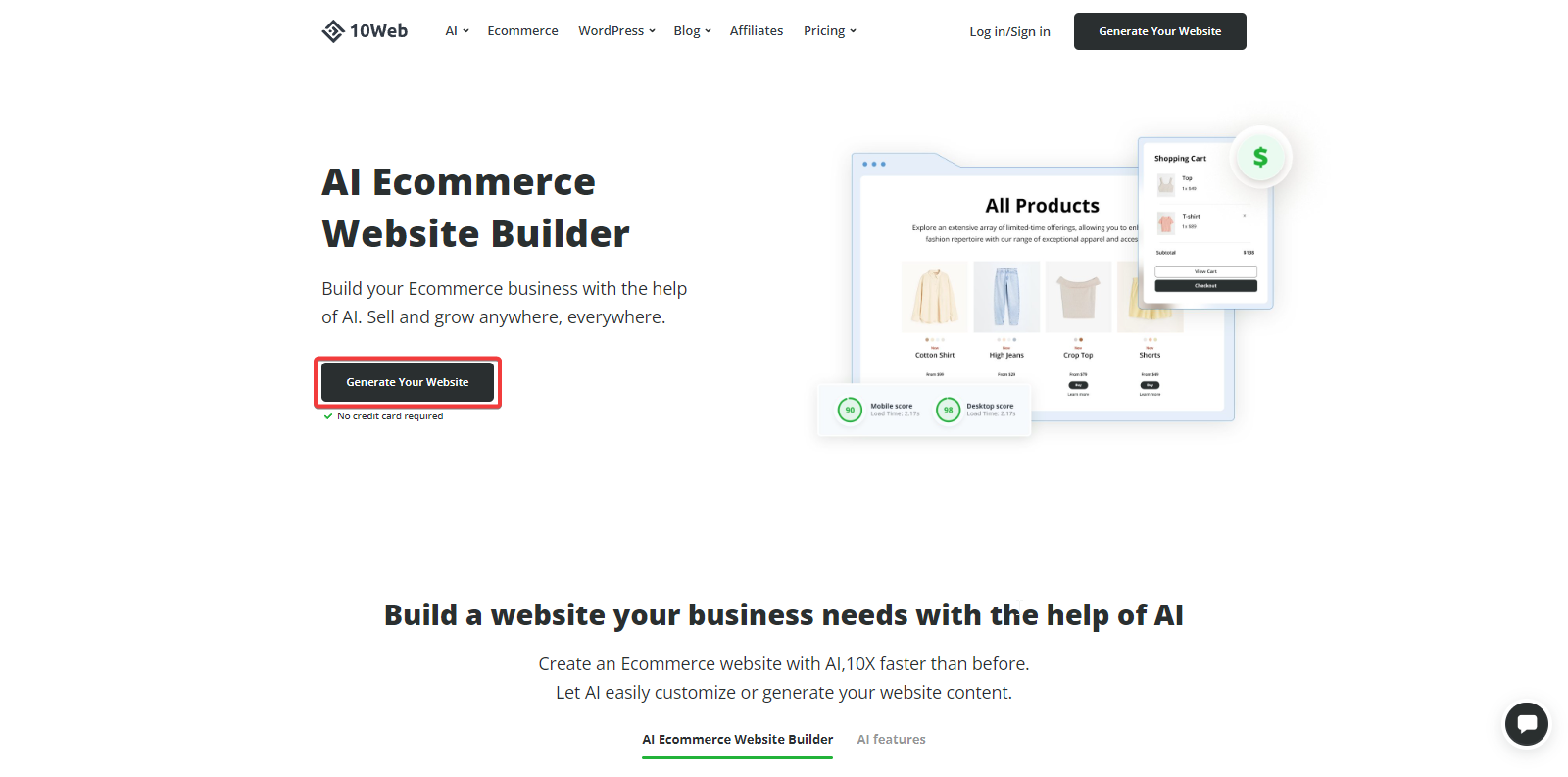
2. Choose store type: From the dropdown menu, select a suitable furniture store type and click “Next”.
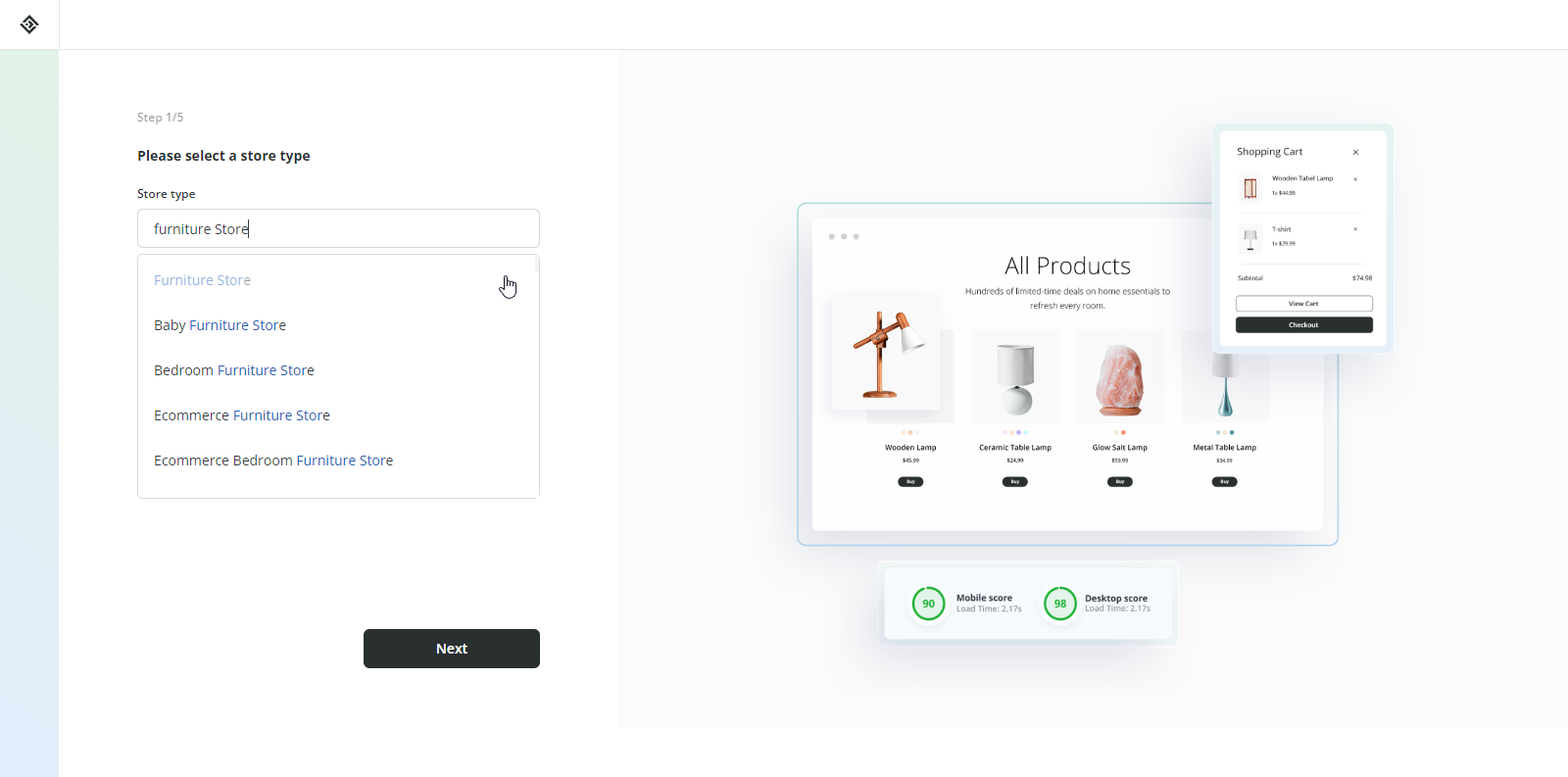
3. Enter store details: Input your store name, provide a concise store description, and click “Next”.
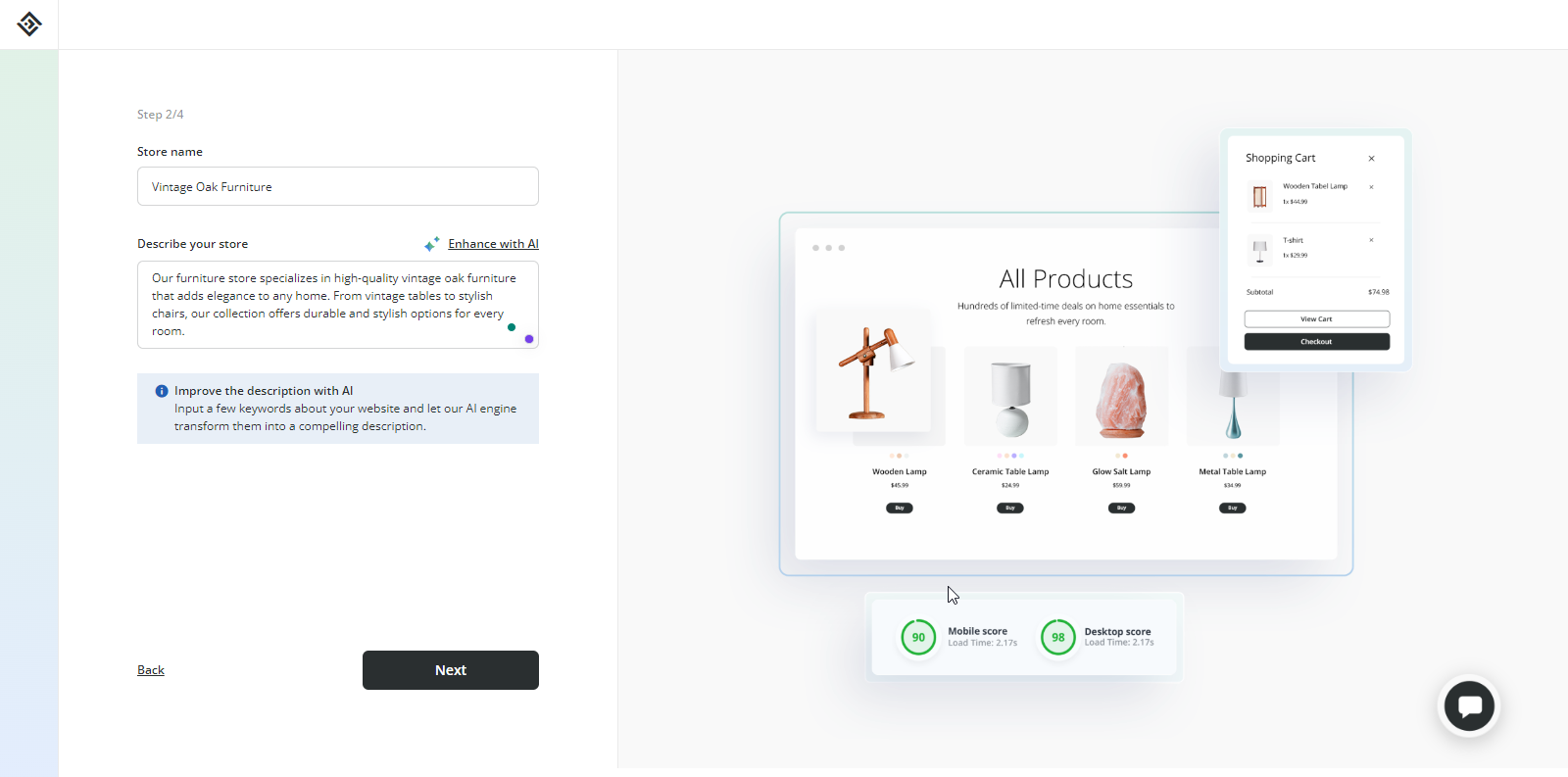
4. Add products and categories: Add the initial three products and categories for your store and proceed by clicking “Next”.
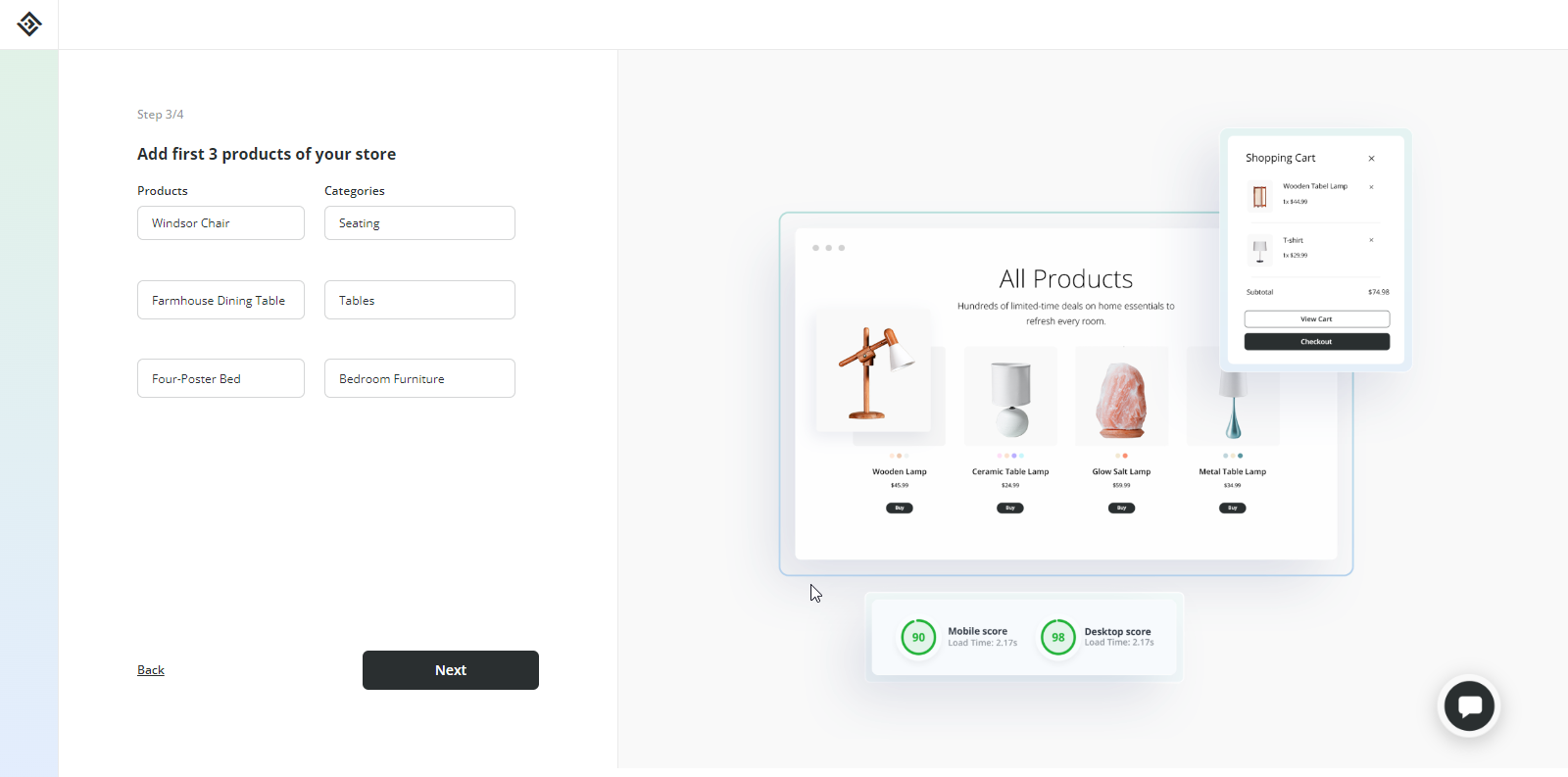
5. Choose the tone of voice: Select a tone of voice for your website’s content and click “Finalize”.
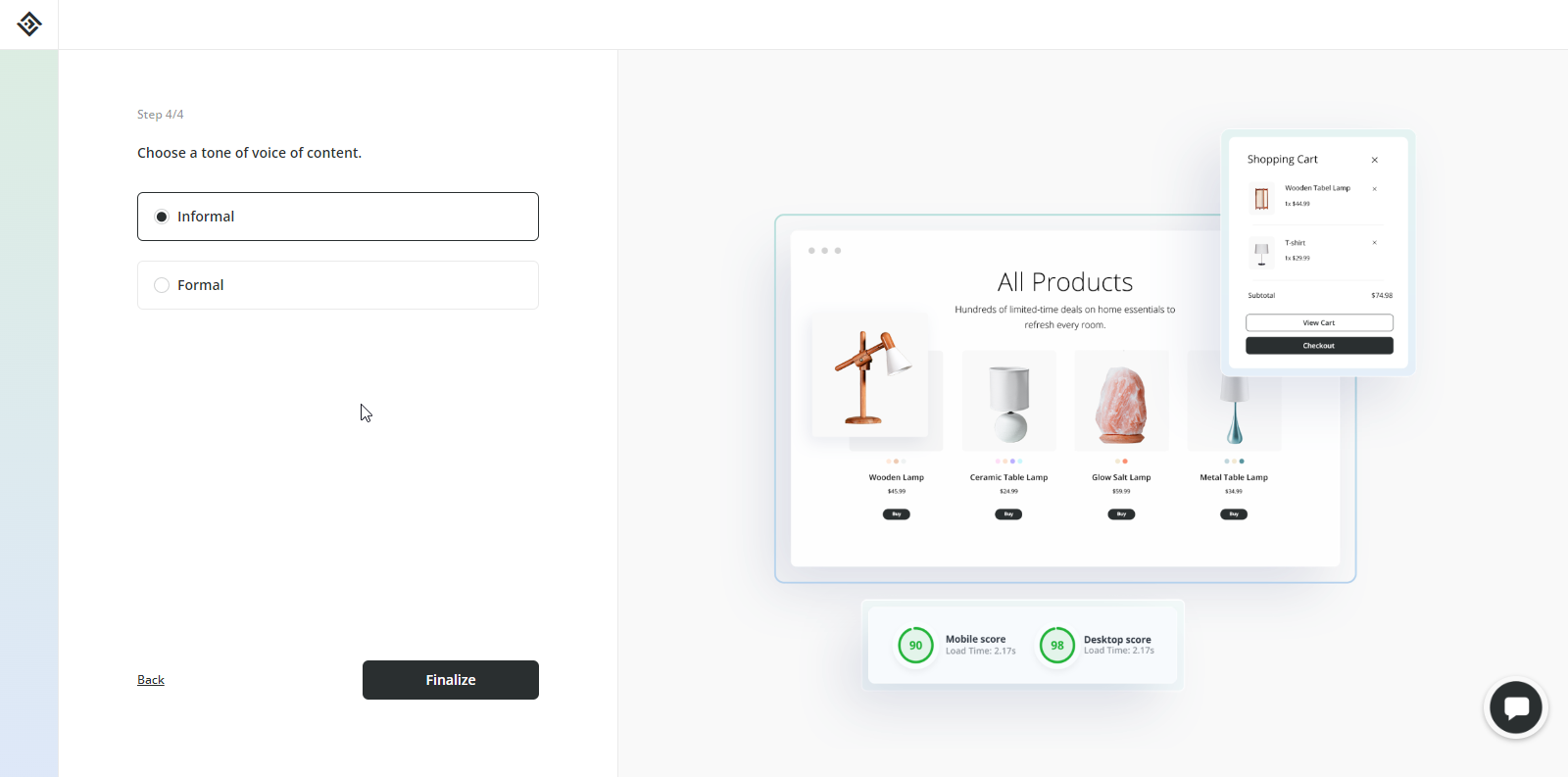
The AI Website Builder will begin the automatic creation of your ecommerce site. Upon completion, a success popup will appear. Now, you’ve taken the crucial first step to selling furniture online.
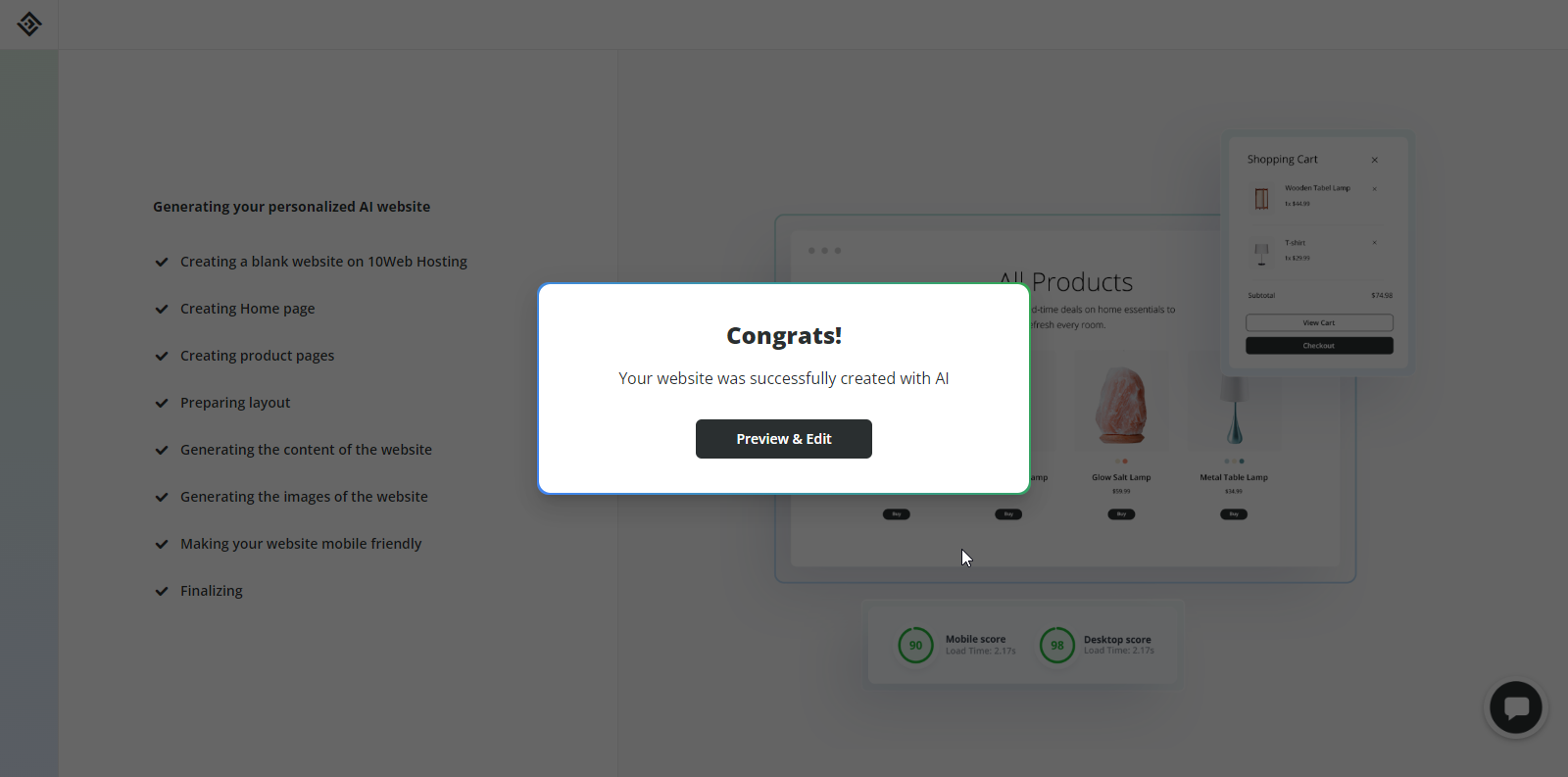
Click “Preview and Edit” to view and make any necessary adjustments to your ecommerce site. After your website goes live, you’ll notice that images are generated using the AI builder.
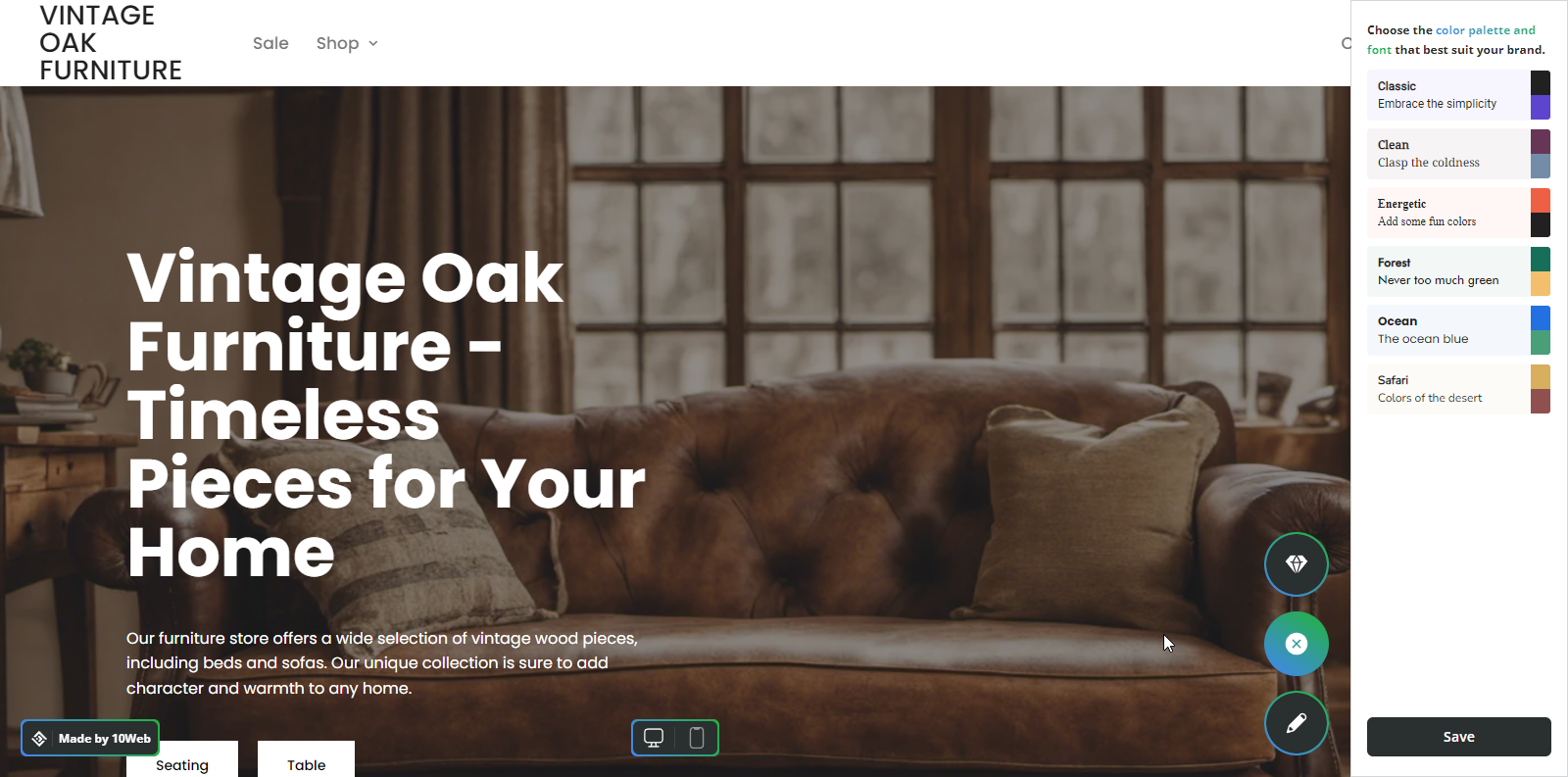
You can personalize the layout, images, and website content. Products are displayed on the site, and you have the capability to add or remove products as needed.
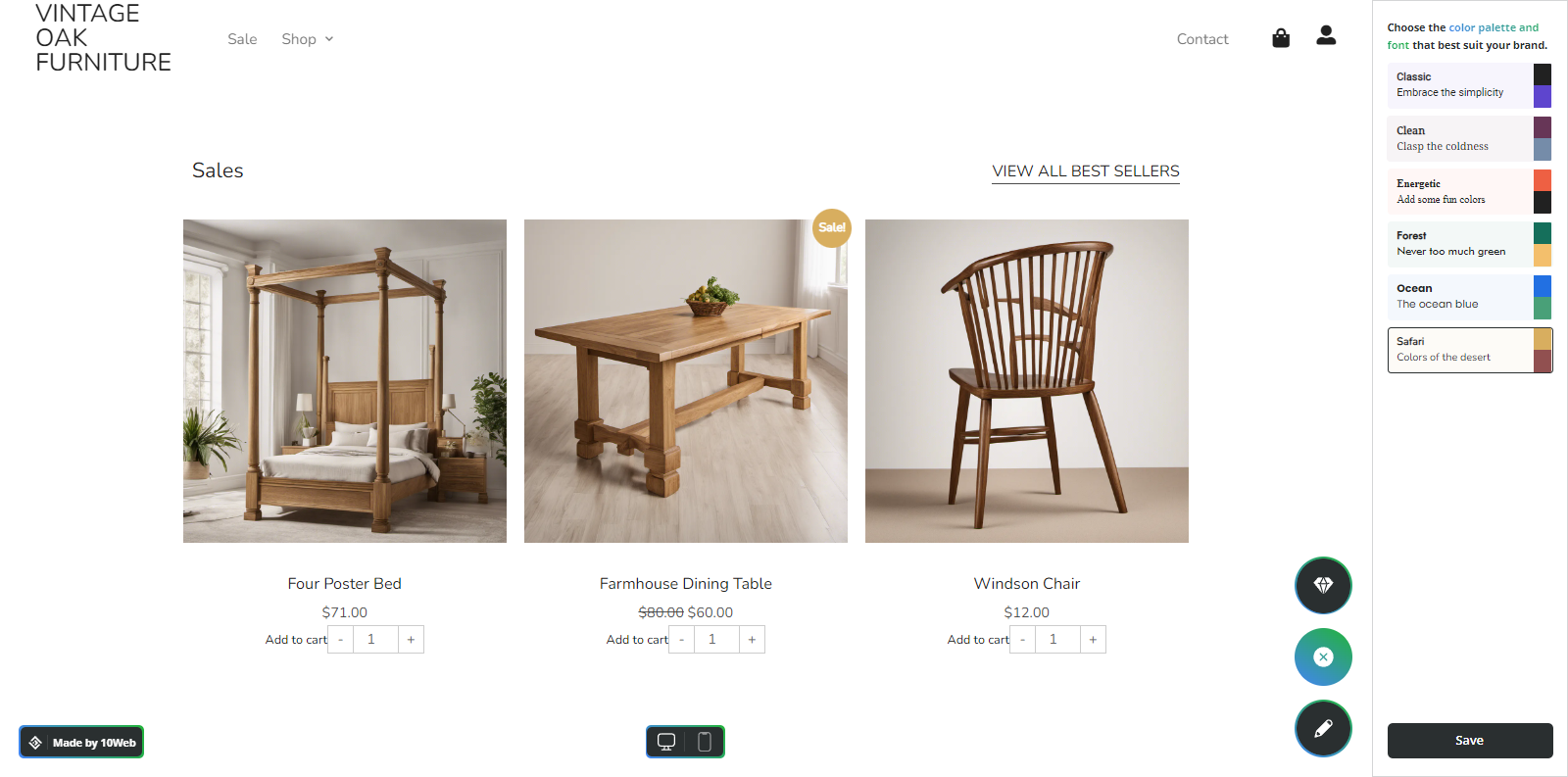
Now, you’re set to receive orders and implement further enhancements.
Here are some of the standout advantages of using the 10Web AI Ecommerce Website Builder:
- Customization and design flexibility: The 10Web AI Ecommerce Website Builder offers a comprehensive platform for crafting websites. Users can experiment with various design structures, motion effects, colors, and typography settings. Additionally, it can improve the site’s functionality with a diverse range of premium widgets.
- Efficient store management: The 10Web AI Ecommerce Website Builder provides an intuitive dashboard for seamless management of orders, products, customers, taxes, shipping, and payments.
- WooCommerce integration: The 10Web AI Ecommerce Website Builder is powered by WooCommerce, offering a robust backend solution. This integration provides users with open-source flexibility, customization freedom, scalability, and the ability to create diverse shopping experiences. Users can harness the power of WordPress and utilize features like hooks, filters, and REST API endpoints to tailor their sites.
- Effortless migration: The 10Web AI Ecommerce Website Builder offers a one-click migration feature, allowing users to easily transfer websites and benefit from an optimized version with a high PageSpeed Score.

Looking to sell online?
Create your custom online store in minutes with 10Web AI Ecommerce Website Builder and take your business online.
4 tips to promote and grow your furniture online store
Effectively marketing your online furniture store requires a blend of traditional and innovative strategies. From the power of paid advertising to the organic reach of SEO, each tactic plays a pivotal role in capturing the attention of potential buyers. Whether you are planning to resell furniture or are interested in furniture dropshipping, here are five tips for selling furniture online:
1. Paid advertising
Paid advertising is a game-changer for online furniture stores, offering multiple avenues to boost visibility and drive sales. Pay-per-click (PPC) campaigns on platforms like Google AdWords ensure your products appear for targeted search queries. Visual-centric platforms like Facebook and Instagram are invaluable for showcasing furniture pieces, while Google’s Display Network facilitates banner placements on pertinent websites.
Additionally, collaborations with home decor influencers can amplify your reach, making paid advertising a holistic approach to marketing your furniture effectively.
2. Prioritize search engine optimization (SEO)
SEO enhances your store’s visibility on search engines like Google. By carefully optimizing your content with relevant keywords, you can attract a larger audience to your platform. Additionally, ensure your website loads swiftly to retain visitor interest.
3. Leverage social media platforms
The popularity of platforms like Facebook, Instagram, and Pinterest makes them invaluable for promoting your online store. Whenever possible, post high-resolution images of your products, and if you dropship, you can use supplier-provided images. It is important to communicate with your audience and acknowledge their feedback to foster a sense of community and trust.
4. Implement email marketing
Email marketing remains a powerful tool in keeping your audience informed and engaged. Regular newsletters updating your subscribers about new arrivals, exclusive deals, or seasonal discounts can foster loyalty and drive repeat business. It’s a personalized touchpoint that can significantly enhance customer retention.
Option 2: Selling furniture in big marketplaces (Amazon, eBay, etc.) (best for seller type 2)
Navigating the expansive world of ecommerce, platforms like Amazon and eBay stand out as prime destinations for shoppers, presenting both opportunities and challenges for selling furniture online.
In this section, we’ll delve into the pros and cons of selling furniture on these major online marketplaces. We’ll then spotlight the most lucrative platforms for furniture sales and wrap up key strategies for success in this competitive arena.
Benefits and drawbacks of selling furniture in an online marketplace
Online marketplaces have emerged as dominant platforms to buy and sell furniture. While these platforms offer numerous advantages, they also come with a set of challenges. Here’s a detailed look into the benefits and drawbacks of selling furniture online on such platforms:
Benefits:
- No initial investment: Selling in a marketplace eliminates the need for an initial investment in an online shop. This means there’s no need for a designer, technical maintenance, or payments for hosting or domains. Sellers can start without investing any money.
- High traffic and low advertising costs: Marketplaces, due to their popularity, receive a high volume of visitors daily. For instance, Amazon gets 200 million unique visitors per month however advertising on Amazon can be equally important to gain visibility in top positions.
- Trust in the marketplace’s brand: Regular customers of marketplaces trust these platforms to such an extent that they often don’t require any information about the individual seller.
- Efficient logistics and shipping: Marketplaces often offer efficient logistics and shipping, with some even providing “free shipping” within short timeframes. They may also offer storage for sellers’ products in their warehouses, ensuring quick and efficient shipping.
Drawbacks:
- Competition and price wars: While sellers have the freedom to set their prices, the intense competition from numerous other sellers often forces them to lower their prices.
- Lack of customer loyalty: Even if sellers opt for traditional logistics where they ship products directly, buyers often believe they’ve purchased from the marketplace, not the individual seller. This perception makes it challenging for sellers to build customer loyalty or conduct subsequent marketing campaigns.
- Difficulty in building a brand: Relying heavily on a marketplace can prevent sellers from developing their own brand. This becomes a regret for many when they achieve significant sales and wish to transition to their own sales channel.
- High commissions: Selling on marketplaces often involves paying a commission on the products sold. This commission can be substantial, sometimes reaching up to 15% in certain product categories on platforms like Amazon.
It’s essential to weigh these benefits and drawbacks when considering selling furniture or any other product in an online marketplace.
8 best places to sell furniture online
Choosing the best place to sell furniture online largely depends on the specific needs of the seller. Each platform boasts unique features tailored to various selling requirements.
Here’s a curated list of the top 8 online marketplaces that stand out in the realm of furniture sales:
Amazon Marketplace
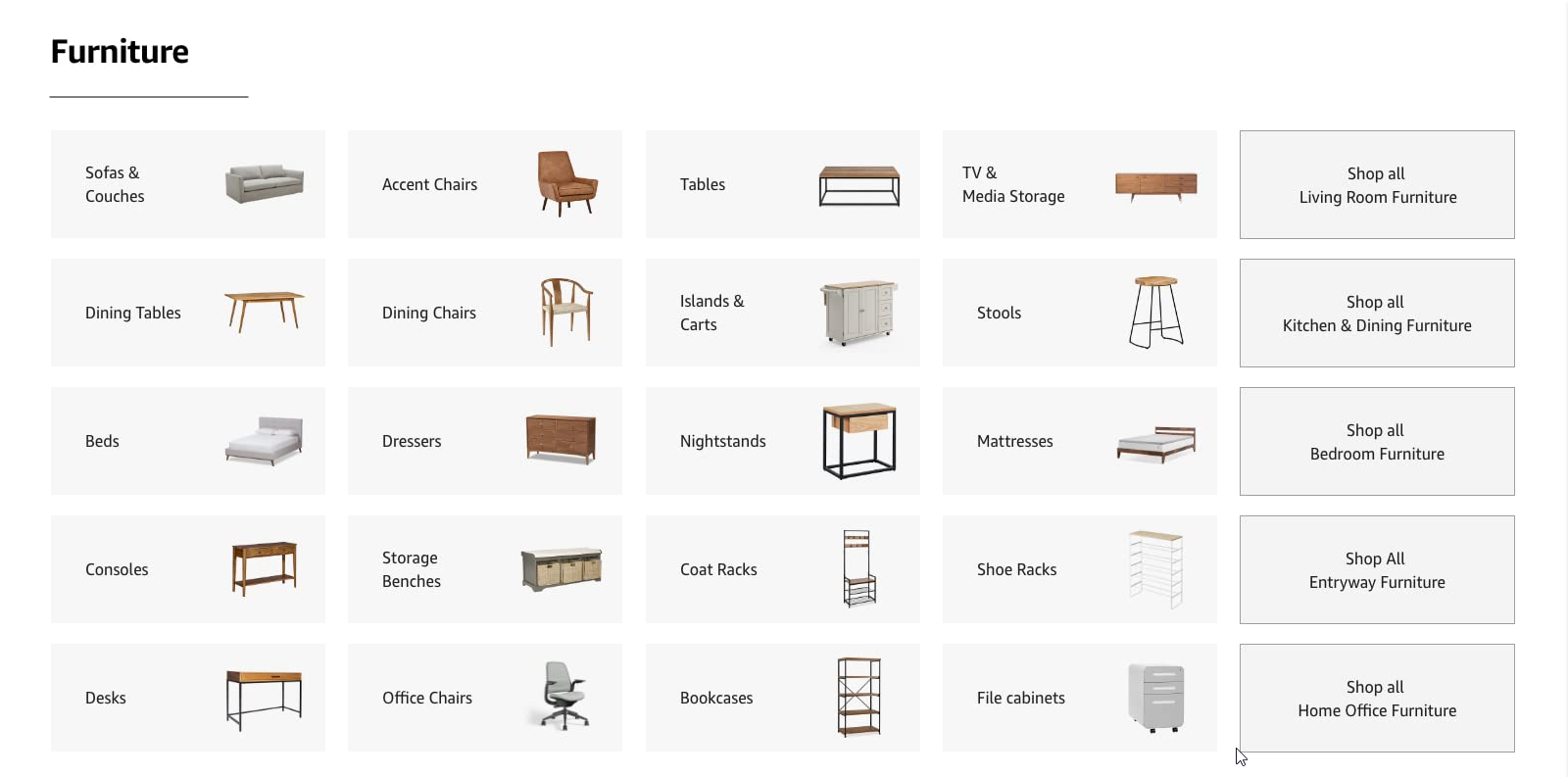
Amazon stands as one of the world’s largest online marketplaces, offering third-party sellers an expansive platform to showcase their furniture. With a selection exceeding 100,000 results under the “Furniture” category, sellers can tap into a diverse audience seeking both new and used items. One of Amazon’s standout features is the Fulfillment by Amazon (FBA) service. With FBA, Amazon takes the logistical load off the sellers by managing storage, packaging, and shipping.
eBay
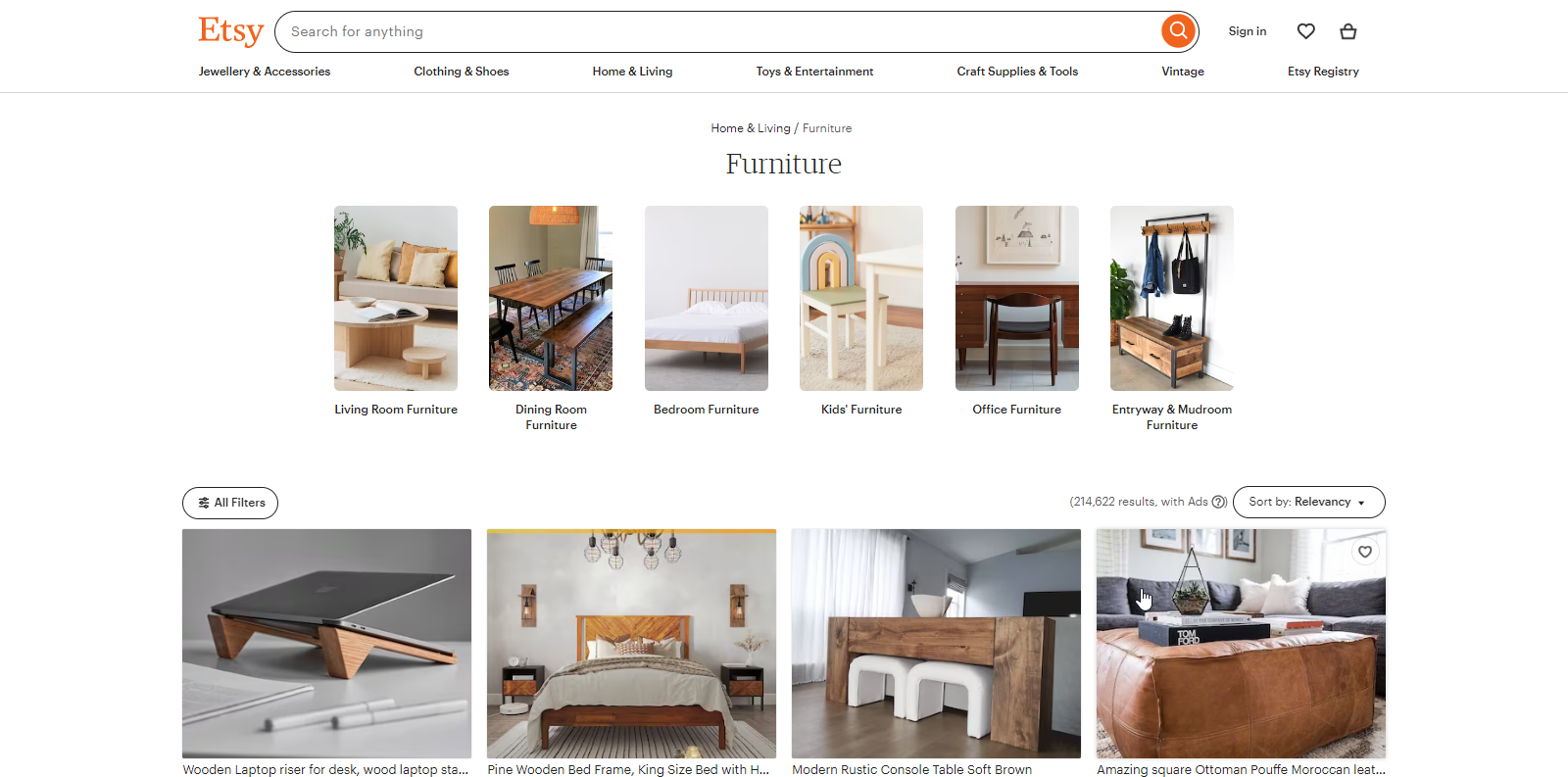
A leader in the online selling arena, eBay offers flexibility with its auction and fixed-price listings. With its global reach and user-friendly interface, sellers can tap into a vast audience, ensuring their furniture pieces find the right buyers. Sellers can expect a 13% commission on the final selling price of their furniture.
Bonanza
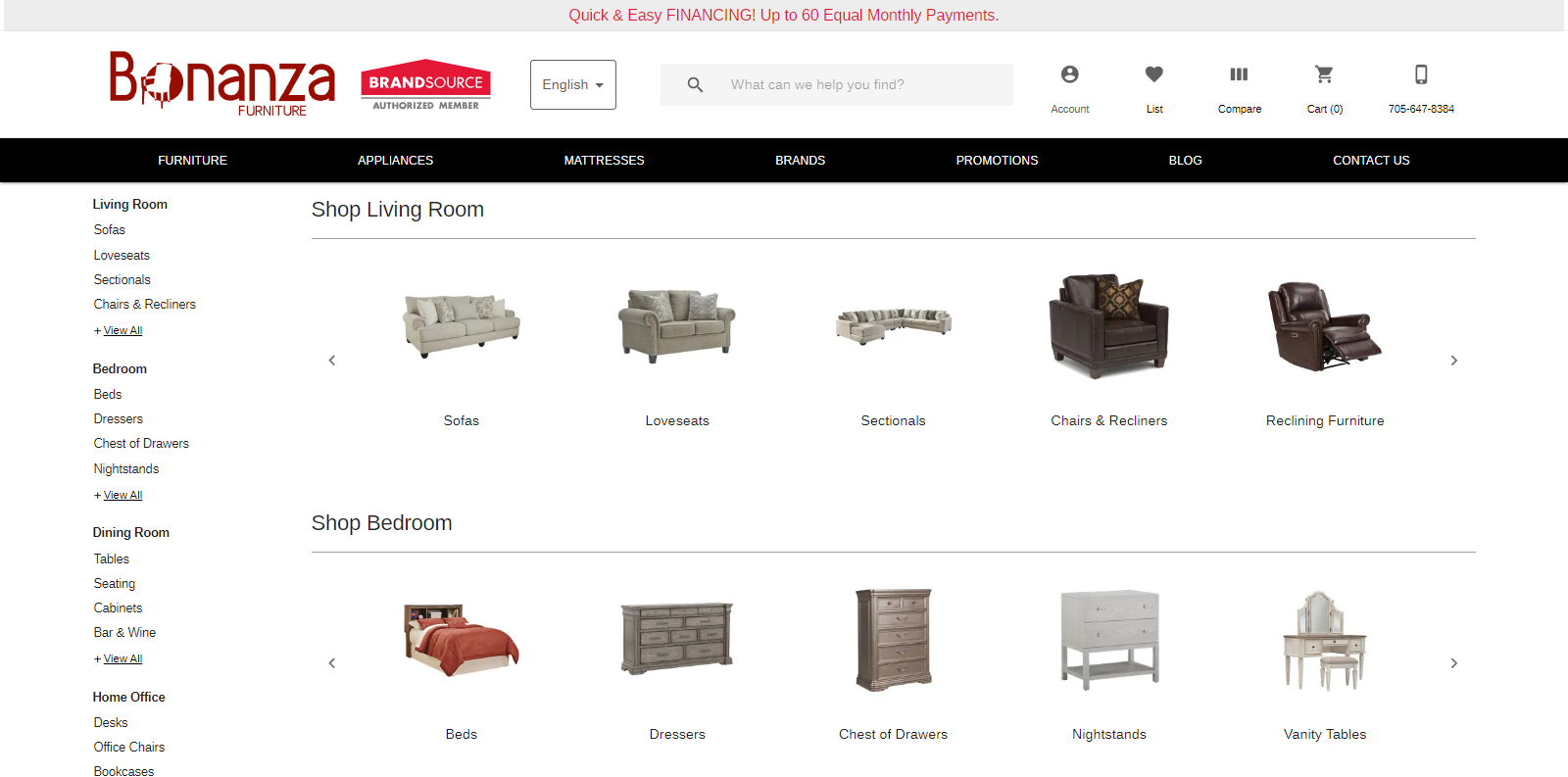
Bonanza, an alternative to Amazon and eBay, offers a unique platform for selling unique goods, including furniture. While there are no listing fees or setup costs, sellers are charged a commission based on their chosen advertising option. The higher the advertising rate, the more visibility from Google Shopping. Importantly, transactions generated through a direct referral link are free of cost.
OfferUp
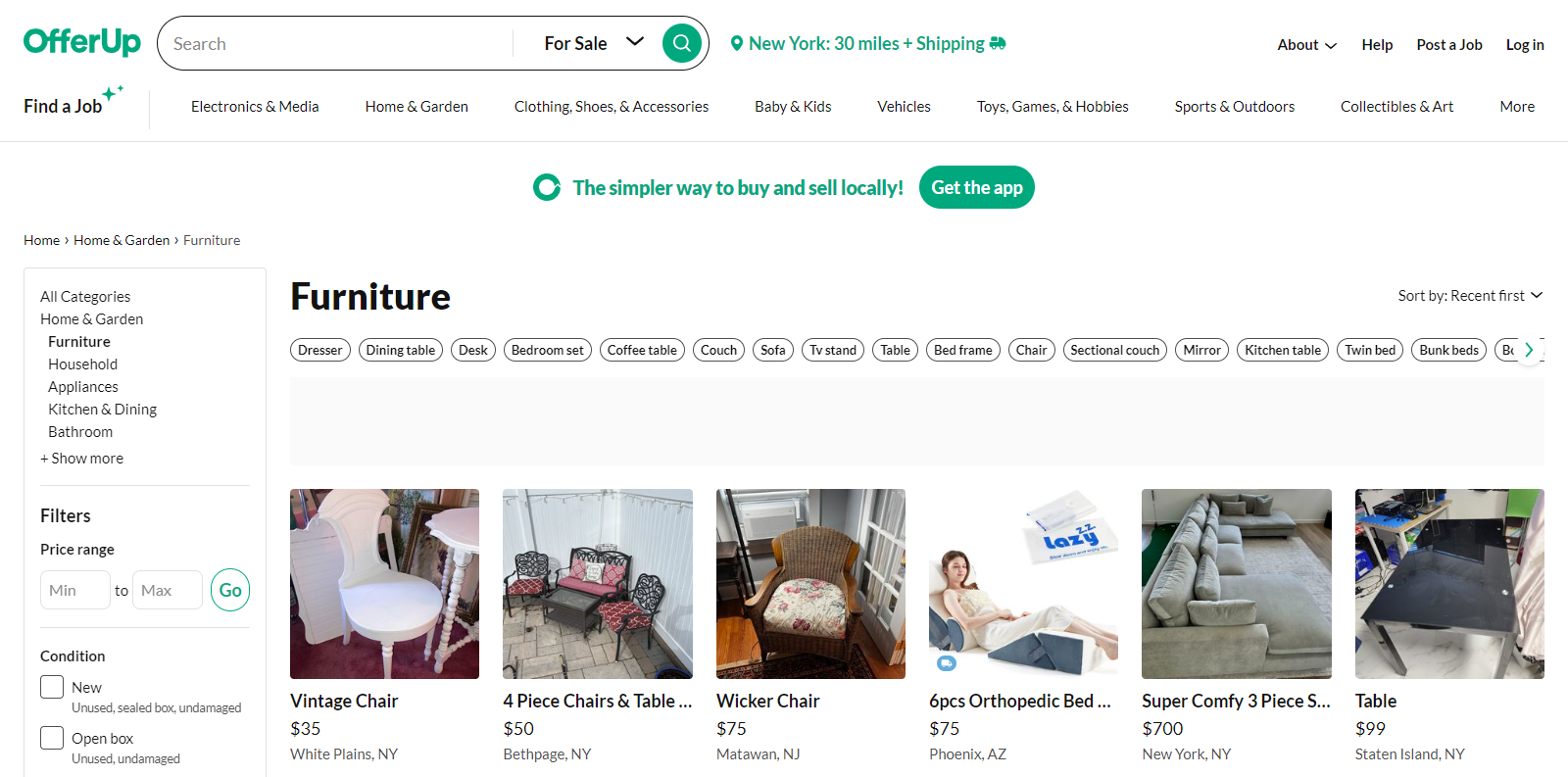
OfferUp is a user-friendly platform that allows for local furniture sales. This platform stands out for its feature that encourages buyers to suggest a counter price. It’s a free-to-use app, with certain transactions possibly incurring service or shipping fees.
Chairish
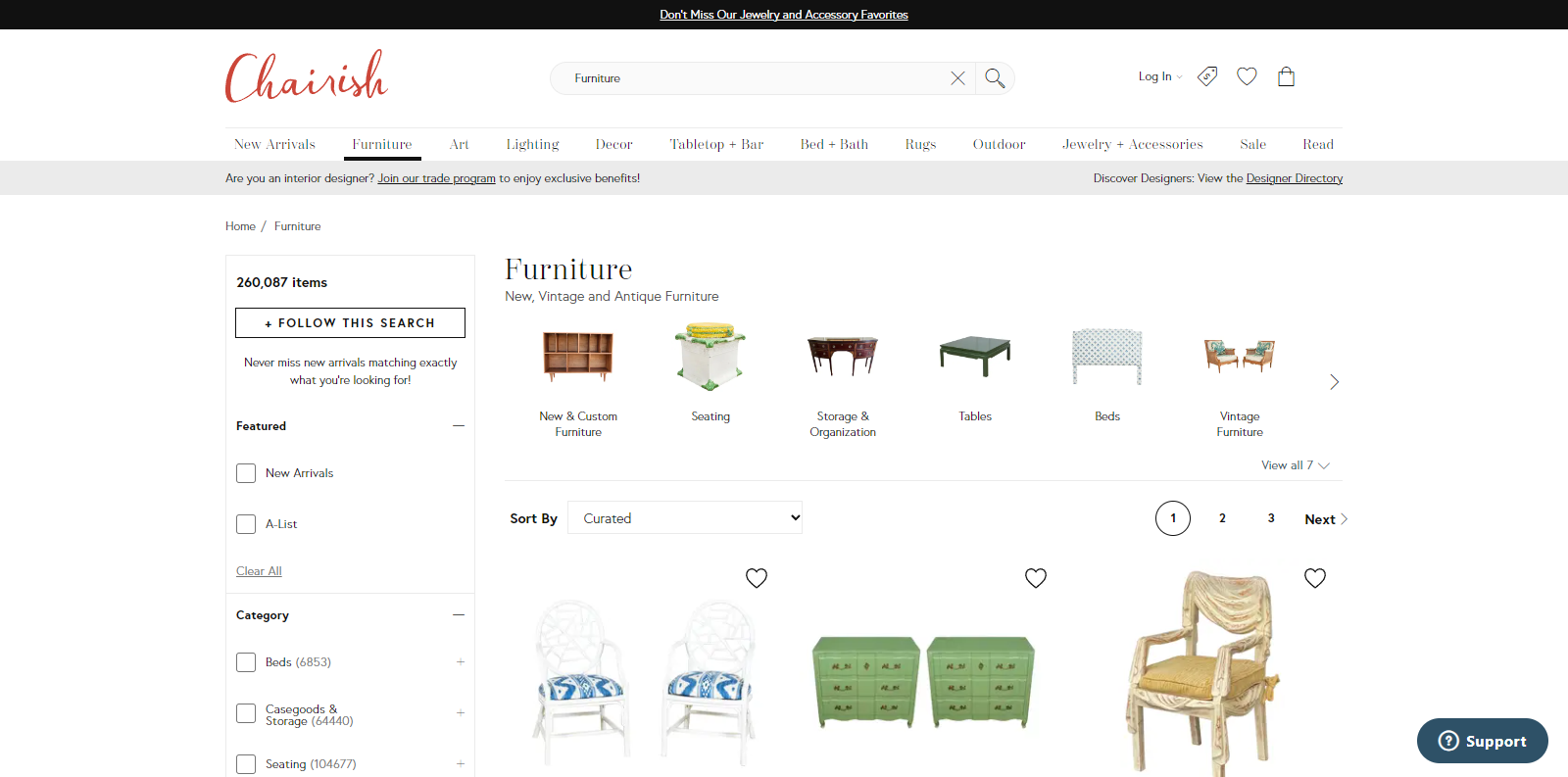
Chairish is a luxury online marketplace tailored for pre-owned goods with a touch of glamour. The platform takes a 20% commission on sales up to $2,500. For pricier items, the commission ranges between 3-12%. While small items enjoy free shipping by the seller, buyers bear the cost for larger items requiring white-glove service.
1stdibs
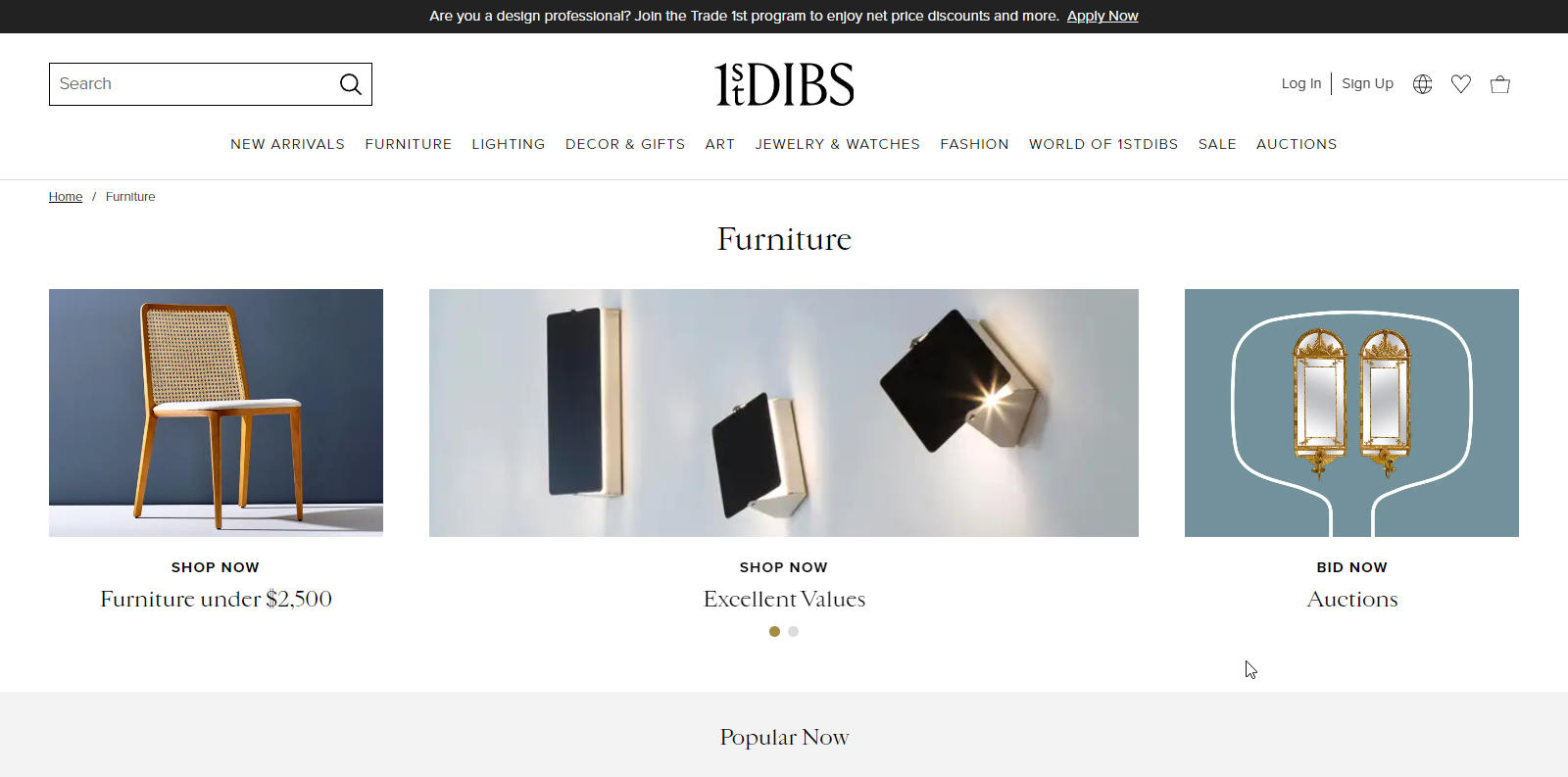
1stdibs is a global marketplace connecting furniture dealers with collectors and curators. After a merchant application is approved, sellers can list their items, with a dedicated account manager overseeing shipping coordination. Sellers pay a monthly fee to list items. On top of that, there’s a commission of up to 15% on each sale and a 3% transaction fee for credit card payments.
AptDeco
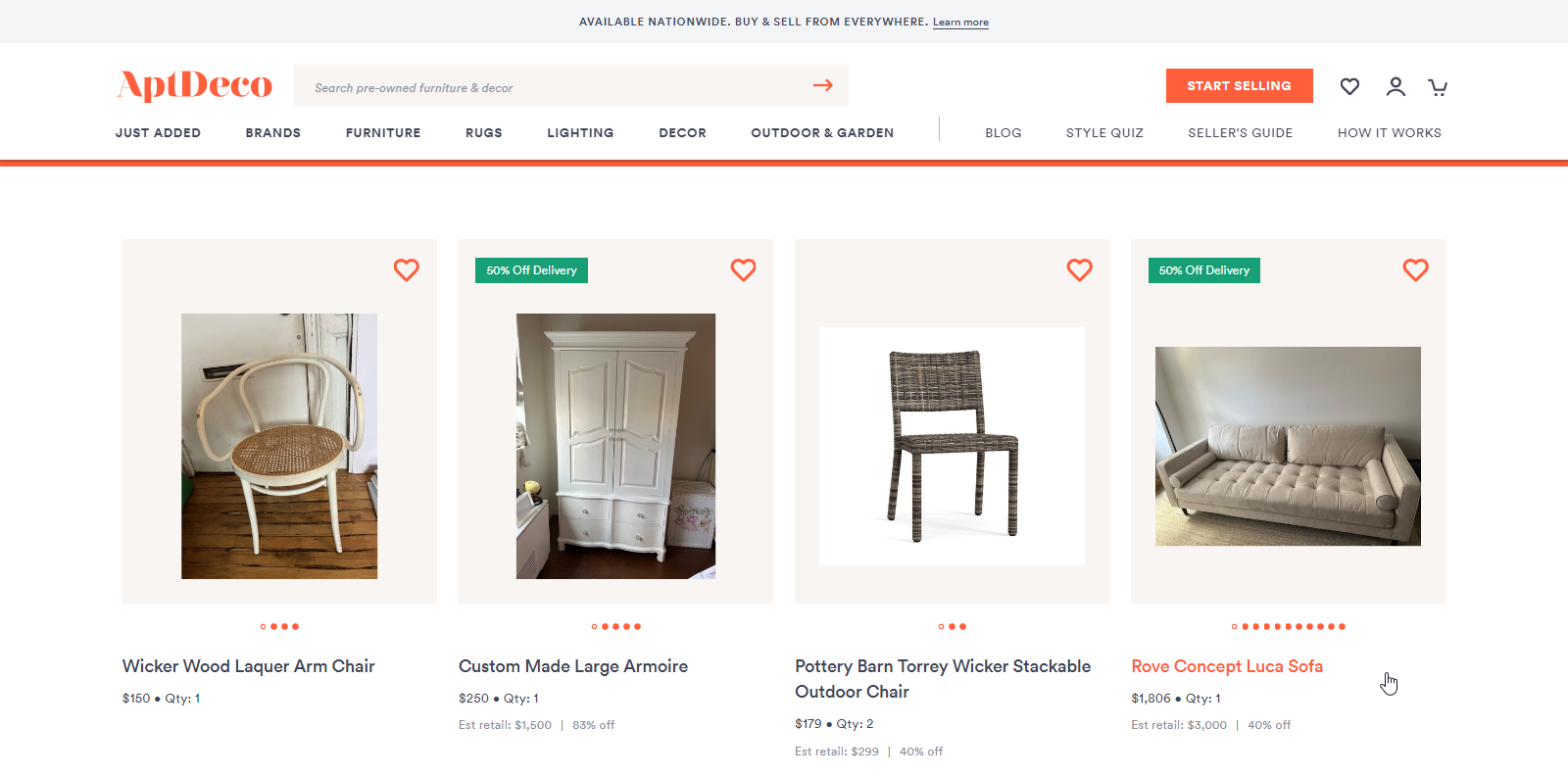
If you are searching for how to sell used furniture, AptDeco is a great platform for the used furniture category. With a streamlined platform, sellers can list their items with ease, and the transparent commission structure ensures there are no hidden surprises. Listing is free, but AptDeco charges a commission between 19% and 29% to facilitate sales.
Etsy
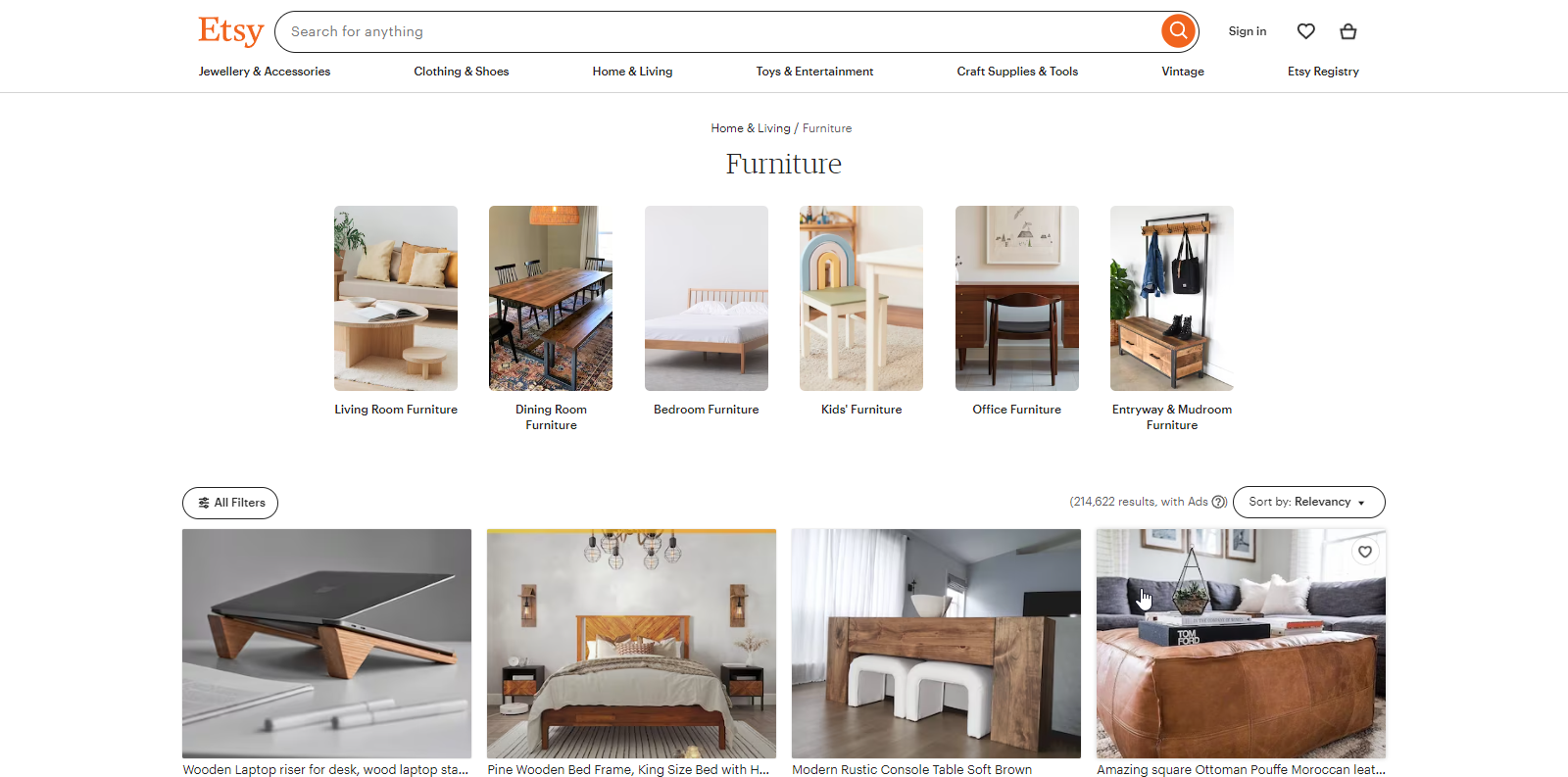
Etsy, known for vintage and handcrafted items, is also a viable platform for furniture sales. Sellers pay a $0.20 listing fee per item, a 5% transaction fee, and an additional 3% plus $0.25 for payment processing. Listings remain active for four months or until sold.
4 tips to successfully sell furniture in an online marketplace
Whether you’re a seasoned seller or just starting out, understanding where and how to sell furniture online is crucial for success. Here are four essential tips on how to sell on the marketplace, ensuring your products stand out and resonate with potential buyers.
1. Diversified listings and brand consistency
To maximize visibility and potential sales, ensure your furniture is listed across multiple online marketplaces. This approach increases the chances of your products being seen and helps you reach different audience segments.
Alongside, maintain a consistent brand image across all your listings. Furthermore, AI image generators are now available to help achieve uniform branding. They can automatically remove backgrounds, replicate designs, enhance product images, and ensure brand consistency across all visuals through custom prompts. To delve deeper into the capabilities of these AI tools, check out this comprehensive blog on the best AI image generators.
2. Honest descriptions and pricing strategy
Transparency is key. Provide detailed descriptions of your furniture, highlighting both its strengths and any imperfections. This honesty can reduce potential disputes and returns.
When setting prices, research similar listings across platforms. It’s important to strike a balance between competitive pricing and profitability, so make sure you don’t overcharge or undersell.
3. Quality assurance and sustainable offerings
Prioritize selling furniture in good condition. If possible, invest in minor refurbishments like cleaning or refinishing to enhance its appeal and market value. If any of your furniture pieces are eco-friendly or made from sustainable materials, highlight these aspects. With growing environmental consciousness, such features can be a significant selling point.
4. Engagement through user content and limited editions
Encourage satisfied customers to share photos of their purchased furniture in their homes. Such user-generated content not only provides authenticity but also gives potential buyers a real-world context. Consider offering limited edition furniture pieces or exclusive deals. Such strategies can create a sense of urgency and exclusivity, driving quicker sales.
Option 3: Selling furniture only on social media (best for seller type 3)
Social media has transformed from just a communication tool to a powerful marketplace. For furniture sellers, especially those looking to target a specific audience or sell pre-owned items (seller type 3), social media platforms offer a unique blend of visual appeal, direct engagement, and targeted marketing.
With platforms like Instagram and Pinterest emphasizing visuals and others like Facebook offering robust advertising tools, selling furniture on social media can be both effective and cost-efficient. The following are some benefits, drawbacks, and strategies for using social media to promote your furniture business.
Benefits of selling on social media
1. Direct engagement with potential buyers
Social media platforms allow furniture sellers to engage directly with potential buyers. This direct interaction fosters trust and provides an opportunity for sellers to showcase their products in a more personalized manner. Through comments, likes, and shares, sellers can gauge interest and adjust their offerings accordingly.
2. Targeted advertising
Social media platforms offer advanced targeting options for advertisements. Furniture sellers can target specific demographics, locations, and even interests. For instance, a seller specializing in mid-century modern furniture can target individuals interested in that style, ensuring that their ads reach the most relevant audience. Moreover, furniture sellers can keep an eye on popular design themes, color palettes, and styles that are gaining traction. This can inform their product development and marketing strategies, ensuring they stay ahead of the curve.
3. Real-time feedback and reviews
Social media provides an avenue for customers to share their experiences and reviews. Positive feedback can boost a seller’s credibility, while constructive criticism can offer insights for improvement. This real-time feedback loop can be invaluable for sellers looking to improve their offerings and customer service.
4. Cost-effective marketing
Compared to traditional advertising channels, social media marketing can be more cost-effective. A furniture seller’s ROI can be improved by starting with a smaller budget and scaling up based on results. Organic posts, stories, and user-generated content can also provide free publicity.
5. Building a loyal community
Over time, furniture sellers can build a loyal community of followers and customers on social media. This community can provide repeat business, and referrals, and act as brand ambassadors. Brands can keep their communities engaged and invested by providing engaging content, exclusive deals, and behind-the-scenes glimpses.
Disadvantages of selling on social media
1. Not primarily business-oriented and limited audience reach
Initially designed for personal interactions, social media platforms might not provide the ideal environment for selling furniture. The inherent lack of a “buying intent” can make conversions challenging. Moreover, not all demographics are active on all platforms, limiting the potential audience.
2. Risk of negative feedback and privacy concerns
The open nature of social media exposes businesses to both negative reviews and potential data breaches. A single negative comment can tarnish a brand’s reputation, and platforms being frequent targets for hackers can jeopardize business and customer data.
3. Paid advertising and low ROI
With declining organic reach on platforms like Facebook, businesses are pushed towards paid advertising. This can become a significant cost, especially for smaller sellers, and there’s no guarantee of a favorable return on investment.
4. Time-consuming and need for continuous engagement:
Managing a social media presence demands consistent effort, from content creation to follower engagement. A lapse in activity can lead to decreased visibility, and the dynamic nature of social media requires continuous adaptation. Moreover, determining the actual impact of a social media campaign on furniture sales can be challenging, as likes and shares don’t necessarily translate to sales.
Tips for selling on social media
Social media can be challenging, especially when it comes to selling furniture online. However, with the right strategies, social media platforms can become powerful tools for reaching a wider audience and driving sales.
Here are some tips to help you effectively sell furniture on social media.
1. Excellent presentation
Before listing, ensure each piece of furniture is in its prime condition. It would be advisable to clean the item thoroughly, make any necessary repairs, and consider refurbishing it if this would enhance its appeal. High-quality images strongly influence a buyer’s decision. To highlight the furniture’s features, take pictures in good lighting, with a plain background, and from different angles.
2. Provide transparent descriptions
Each piece of furniture should be described in a clear and honest manner. A description of the dimensions, material type, and unique features should be provided. A close-up photograph of intricate patterns or minor wear and tear can enhance the buyer’s trust in the product.
3. Craft an engaging content strategy
By understanding your audience’s preferences, you can curate content that is both engaging and relevant. Post content that aligns with your audience’s interests, such as tips on furniture maintenance, design inspirations, or DIY refurbishing guides. Hosting live demonstrations or Q&A sessions can further solidify your position as an expert in the furniture industry. For a deeper dive into leveraging technology in content creation, check out this article on AI in content marketing.
4. Foster genuine relationships
Active engagement is the cornerstone of social media success. Take the time to respond to comments, participate in relevant discussions, and ensure your followers feel valuable. Whether it is sustainable practices, bespoke designs, or unmatched customer service, you should highlight what makes your brand special.
5. Encourage user-generated content
Encourage satisfied customers to share their positive experiences and photos of their furnished spaces. Consider running contests that allow customers to flaunt their creativity using your products. Such initiatives enhance engagement and provide you with authentic content for promotions.
Related Articles
Conclusion
Selling furniture online is a dynamic venture that requires a blend of strategy, adaptability, and understanding of the digital landscape. Whether you’re a craftsman showcasing your creations, a reseller tapping into the vast ecommerce market, or an individual looking to sell pre-owned pieces, the right tools can make a significant difference in achieving business success.
A well-crafted website serves as the digital storefront for businesses. Therefore, tools such as 10Web AI Ecommerce Website Builder are useful for any type of seller looking to venture into the online selling space. The platform is designed with simplicity, ensuring that even laymen can effortlessly set up and manage their online store. By utilizing personal online stores built with 10Web, sellers gain access to a suite of powerful features tailored for seamless ecommerce operations.
However, it’s essential to stay informed, engage with your audience, and continuously refine your approach based on feedback and evolving trends.

Looking to sell online?
Create your custom online store in minutes with 10Web AI Ecommerce Website Builder and take your business online.
FAQ
How to deliver my furniture internationally?
How much money do I have to have to start an online store for selling furniture?
- Storage: If you’re storing the furniture yourself, this could be a few hundred dollars per month for a storage unit.
- Shipping: This includes the cost of packing materials and shipping fees for large items like furniture.
- Marketing: This could involve costs such as online advertising, email marketing software, and potentially hiring someone to help with SEO or social media.
- Other costs: These might include business licenses, insurance, and taxes.
Can I set up the store on my own, or do I have to hire a dev team?
What is the best option for selling vintage furniture?
Wait!
Your online store
is a click away
Your online store is a click away
-
Create an ecommerce website in 1 minute with AI
-
Set up and manage payments, products & more
-
Grow your business with all in one platform






 Create an ecommerce website in 1 minute with AI
Create an ecommerce website in 1 minute with AI 







